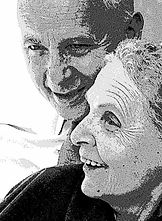

Society of Friends
by Louis Aragon and Elsa Triolet
Portrait
by Louis Aragon
the war as an auxiliary doctor, that the politician Louis Andrieux is his father.
At the Val de Grâce hospital, he struck up a friendship with André Breton. From 1918, he published his first poems and met Paul Éluard, Philippe Soupault, Tristan Tzara... He collaborated with the magazine Littérature. In October 1924, he published Une Vague de rêves which can be considered as the first Manifesto of Surrealism, of which he was the founder with André Breton and Philippe Soupault.
On January 6, 1927, he joined the French Communist Party. At that time, he led a troubled sentimental life. His passionate affair with Nancy Cunard would inspire him with many poems but would end in a dramatic way with a suicide attempt in Venice in September 1928. Already this first period of Aragon's work was rich in literary creations (Le Paysan of Paris, Treaty of style, La Défense de l'infini, ...).
On November 5, 1928, Aragon met Maïakovski at La Coupole, a center of artistic life in Montparnasse; the next day, at the same place, Roland Tual introduces him to Elsa Triolet, friend of the Soviet poet. Aragon will make their love one of the great literary myths of the 20th century. Elsa opens the doors to a new cultural continent, that of Soviet literature. It is also the time of the break with the members of the surrealist group.
Writer, journalist, director of the daily Ce soir (with Jean-Richard Bloch), in 1937, he joined the fight against fascism which threatened Europe. Called up again in 1939-1940, he brilliantly participated in the defense of his country.
After the Armistice of June 40, he refuses, with Elsa, the proposals made to them to take refuge in the United States and decide to stay in France. Installed in the "southern zone", Aragon takes an active part in the Resistance. It attaches to the regrouping of anti-fascist intellectuals in hiding, to the publication and edition of works and underground newspapers (Les Lettres françaises, Les Étoiles). This is the period of the "poetry of the Resistance" characterized by the exaltation of national feeling by resorting to the sources of French poetry of the Middle Ages. The impact of his clandestine work is considerable and gives him great notoriety.
All his life, he never ceased to pursue his work as a poet, novelist and journalist. At the Liberation, he chaired the National Committee of Writers, he took over the management of Ce soir and then that of the weekly Les Lettres françaises. He contributes articles to L'Humanité and participates in the debate on his party's cultural policy. In the difficult context of the Cold War, he is the writer of all the fights for freedom of expression, a stakeholder in the questions that shake the world, a discoverer of young talents, an attentive witness of his time.
On the threshold of old age, his work took on a new direction: he mixed poetry and the novel, abolished the boundaries between fiction and autobiography... He questioned the codes of romantic and poetic writing.
He died in Paris on December 24, 1982.
Portrait
by Elsa Triolet
Elsa Triolet was born in Moscow on September 12, 1896, into a Jewish family of the Russian intelligentsia. She was involved very early in intellectual life, with childhood friends, Roman Jakobson, Victor Chklovski. Very young, she met Pasternak, Ossip Brik, Maïakovski, Maxime Gorki...
Little passionate about political events in Russia, she studied architecture and met André Triolet, whom she married and followed to his diplomatic post in Tahiti. In 1921, she separated from André Triolet and returned to Europe. Thus begins for Elsa a life of wandering in Berlin, London and finally Paris.
In Paris, she frequents the "Montparnos", reads the surrealists. Her friends are Marcel Duchamp, Jeanne Léger, Man Ray, Francis Picabia. On November 6, she met Louis Aragon at La Coupole, whom she wanted to meet after having read Le Paysan de Paris. At that time she wrote and published in Russian. In 1929, she moved in with Louis Aragon. They will never leave each other.
She chooses to write in French in secret from Aragon, in particular articles to familiarize herself with the French language and in 1938, she completes her first novel in French Bonsoir Thérèse, the reading of which upsets Aragon.
Then comes the difficult period of the war where Elsa's life is closely linked to that of Aragon. They are distinguished by a courageous action in the Resistance, especially among intellectuals. Her literary work did not stop however and after the war, she continued her action within the National Committee of Writers, of which she was the secretary, and wrote sections for French Letters.
Her talent as a novelist is recognized: she is the first woman to receive the Goncourt prize, obtained in 1945 for Le Premier accroc cost two hundred francs.
From this period, she develops her activity as a writer, translator, defender of freedom of expression. Always alongside Aragon, she keeps her strong personality and her literary originality. From the end of the 1950s, she suffered from arteritis, a disease that would kill her on June 16, 1970. She devoted the last years of her life to writing and to the joint venture of the Œuvres romanesques crossed.
She rests with Louis Aragon in the garden of the Moulin de Saint-Arnoult-en-Yvelines. “When side by side we will finally be recumbent figures, the alliance of our books will unite us for better and for worse in this future which was our dream and our major concern, to you and to me. Death helping, we might have tried and succeeded in separating us more surely than the war in our lifetime: the dead are defenseless. So our crossed books will come black on white, hand in hand, to oppose being torn away from each other. (Introduction to Crossed Romanesque Works, 1964).

